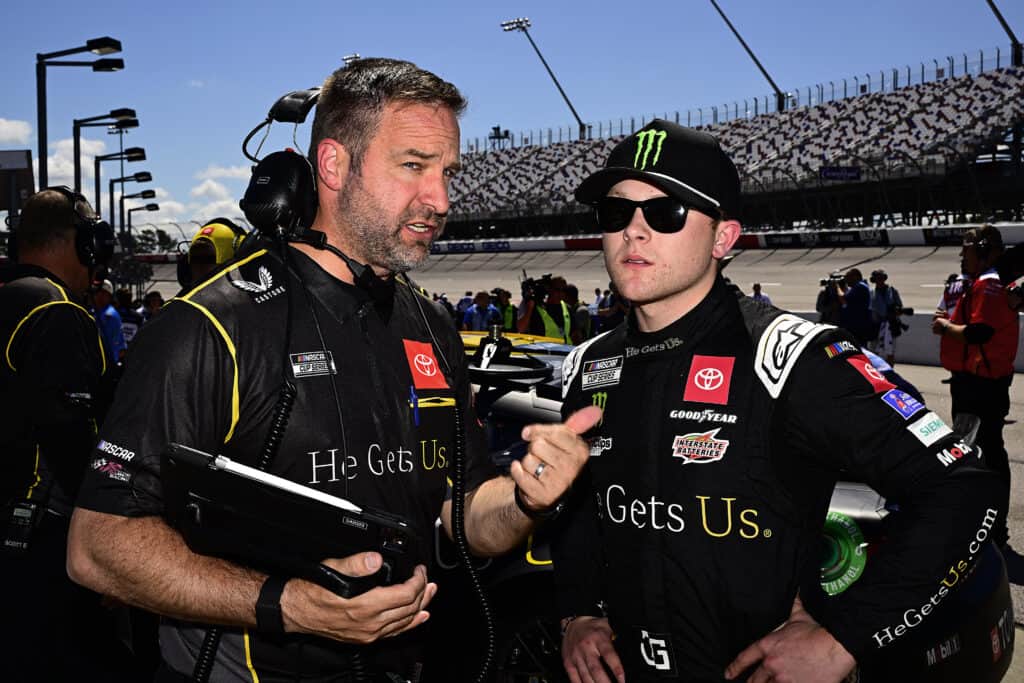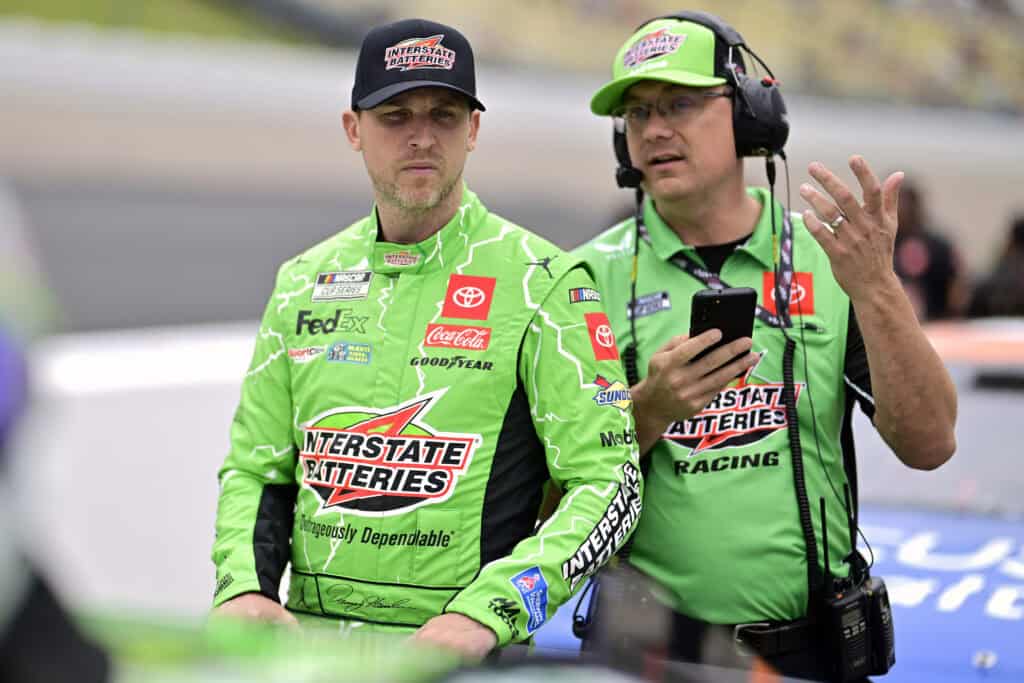By Cole Cusumano, Staff Writer
CHICAGO – One could make the case that NASCAR Cup Series crew chiefs have the most important job in the garage. These master strategists are tasked with everything from dialing in the car, to orchestrating a near-flawless race, along with other countless, inconceivable duties.
But above all else, these engineer-minded geniuses have the responsibility of leading a world-class stock-car racing team composed of some of the most intelligent and athletic individuals in motorsports – a job that should be held in the highest regard.
In a sport where to-the-number calculations could be the difference between victory and defeat, an exorbitant amount of time is put in by crew chiefs on a daily basis to keep up with the competition through 36 points-paying races. However, as is the case with professional sports and its constant evolutions, they’re also expected to embrace and overcome infinite unknowns.
Throughout June, Cup crew chiefs were pushed to their limits with a strategy-heavy five-race stretch. Over those five weeks, numerous drivers ran out of fuel, including Ryan Blaney as the leader on the final lap at Gateway, Martin Truex Jr. running second on the last turn at Sonoma and Kyle Larson from second at Nashville – among many others – in an event that spawned a record five overtime restarts.
NASCAR also went to a brand-new track in Iowa Speedway, which had a partial repave, and debuted wet-weather tires for the first time in competitive conditions on an oval at Loudon.
As the summer months carry on and into the waning stages of the regular season, things won’t get much easier for crew chiefs. To kick off Fourth of July weekend, NASCAR returns to Downtown Chicago for the second-ever street course race.
For all intents and purposes, the Chicago Street Course is unequivocally the most challenging stop on the circuit for crew chiefs. But it’s a weekend widely acclaimed by the strategists, who can flex their creativity and knowledgeable prowess.
“That was about as all-encompassing of a very strategic-heavy, unknown race that we’ve had in a long time,” Cliff Daniels, crew chief for Larson and the No. 5 team, said of his experience at Chicago last year. “Calling that race was about as fun and as pure and as genuine as we’ve had in a long time, just because of the unknowns and all the factors that really came into play.”
Outside of simply competing on a street circuit for the first time in the sport’s 75-year history to that point, there were seemingly never-ending variables hurdled towards teams throughout the entire event.
After practicing a qualifying in dry conditions, torrential downpours that began Saturday evening flooded into the day of the Cup race and delayed the start of the Grant Park 220 by almost two hours. In order to get the event going, teams began the race on wet-weather tires, then had to make the hasty judgment call for when to switch to slicks as the track dried.

Coinciding with the delay, the race was also shortened from its advertised 100-lap distance to 78, due to the threat of darkness. Having made the decision rather abruptly (and shortly after the end of Stage Two), this put many teams in a bind with varying pit strategies, including Ty Gibbs’ No. 54 crew led by Chris Gayle.
“There were just a lot of unknowns,” Gayle said. “I think it went pretty well, but to be quite honest, with the rain in the beginning, it was probably as chaotic as it could have been. Then, NASCAR shortened the race during the middle of it, where some guys had already pit and could make it to the end on fuel to the new scheduled distance, and others had yet to pit.
“That really left the crew chief going, ‘Well, this really isn’t fair. This isn’t the right way to do this.’ You walked away from there kind of upset with how the finish went.”
Looking ahead to the second race on the Chicago Street Course, there are some things crew chiefs can still apply from last year’s chaotic event, while a slight sense of familiarity should make things a little less daunting.
Surprisingly, one of the largest unknowns faced by teams in 2023 were logistics. Everything from where to park the haulers, to walking nearly one-mile to and from the hotel to the circuit, and even where to go in general was very foreign to most everyone in the sport.
“The logistics were the focal point,” crew chief Chris Gabehart of Denny Hamlin’s No. 11 team said. “The on-track activity was almost secondary. All those things are very regiment. We’ve been doing them forever. Well, it wasn’t in this case. So, the on-track product was the most familiar thing about what we had done. Yeah, it’s a street course race, but they’re race cars: the drivers sit in them, they have four tires on them and we figure out how to make them go faster.
“So from that perspective, I feel like we will iterate and be a little bit better, and that’s normal. But the big relief this week is that all logistics are more known. We’ve done it once, so all of the anticipation feels a lot different.”
In regard to the race itself, there’s some information that can be carried over, but there are also contradictions and uncertainty surrounding strategies.
“I think from a race management standpoint, (Chicago) presented a lot of cases for unknown circumstances from which you can learn and build, of course,” Daniels said. “You had the natural transition of the track … Plus, with the impending darkness, there was the unknown of when the race was going to end and how to set yourself up on a fuel mileage game.
“Ourselves and several others made a decision to make sure we could make it to the true, home-number fuel lap to the advertised distance of the race,” Daniels added. “That put us a little bit behind, and just through those couple circumstances and plenty more that we encountered, that presented a lot of great learning opportunities. Will it directly apply apples-to-apples this weekend? I doubt it. But I think a lot of the scenario based decisions and trends that we saw will apply as factors in your decision making, now that we’ve seen the way last year played out.”
Last year, there were nine cautions for 21 laps, which accounted for 27% of the race. On top of that, the most laps run consecutively under green-flag conditions were 15, while the next-longest run was just eight (twice).
The challenges associated with a lack of rhythm mainly impacted the drivers’ abilities to assess the car – especially when you consider there was a natural transition between damp and dry track conditions. This, in turn, made it difficult on the crew chiefs to refine and optimize an otherwise brand-new setup.
As to why the cautions were so extensive, that’s a product of the circuit’s construction. On normal road courses, there are an abundance of runoff areas, which typically allow drivers in trouble to collect themselves and minimize the chance for a yellow.

“There’s no other road course where they’re basically driving in a tunnel of walls,” Gabehart said. “Every other road course these guys drive on, they have a lot of runoff. This road course, there is none. Every apex you approach, if you approach it wrong, you’re going to hit a wall. Every exit that you leave a corner, if you leave it just wrong, you’re going to hit a wall. No other road course is that unforgiving on this circuit.”
From a crew chief’s perspective, preparing for a race on the Chicago Street Course versus a traditional, longer-tenured road course is wildly different.
The 12-turn, 2.14-mile circuit that runs through the streets of the Windy City presents a wide variety of irregular track surfaces ranging from old and abrasive pavement, stretches that are repaved, and even areas that have elevation changes.
“Other places, you’re going to a purpose-built race course with a smoother surface, and we have really good scans and a lot of them,” Gayle said. “So you’re able to kind of choose setups that optimize downforce.
“Over here, there’s a lot more unknowns and driver lines that are going to be taken that might upset the car. So you might choose different springs and such to kind of help that. I think that’s the biggest thing from a crew chief’s set-up standpoint.”
The most drastic difference in competing on the street course compared to other road courses on the schedule are the aggressive bumps. Although Daniels said the bumpiest course on the circuit is the Charlotte Motor Speedway ROVAL, he admitted there isn’t much at all that correlates to Chicago, outside of ride-height anticipation and strategy calls.
“Getting the ride of the car and the grip of the car to be able to handle the transitions over the streets and the bumps and pavement transitions, that’s really critical (to) where you can’t just run your ‘normal’ road-course style setup,” Daniels said. “I would say, what makes it similar is you still have to to be able to execute different strategies that could play out, which seems to to be the case in some Next Gen road course races; guys that pit early, guys that pit late, guys that pit more or less times than another one.”
Finally, as if things couldn’t get more challenging, this weekend’s race was shortened by 25 laps of the advertised distance in 2023, and three laps less than what was completed in the inaugural event for 75 total.
When you also consider track conditions are expected to be much drier than the first race in Chicago, it forces crew chiefs to devise a whole new game plan for the Grant Park 165 on Sunday at 4:30 p.m. ET on NBC, setting up what should be a completely different product from last year.
“The race length is actually 25 laps shorter than last year, and if it runs entirely in the dry, those two things will make it feel very different,” Gabehart said. “A wet-weather race has a lot different feel to it, both from a driver optimization perspective and from a strategy optimization perspective.”
“The way everyone was playing last year’s race, I believe it was two (pit) stops guaranteed, maybe a three-stop race,” Daniels added. “I think this year is going to be one-stop guaranteed … maybe a two-stop race, with the X-factor being cautions that could come into play.
“That could change the fuel economy for everyone. It’s definitely changed it up a bit, so we’re going to have to really pay attention to what happens with cautions and green-flag runs and fuel economy to assess where we’re going to be on that side of the strategy”